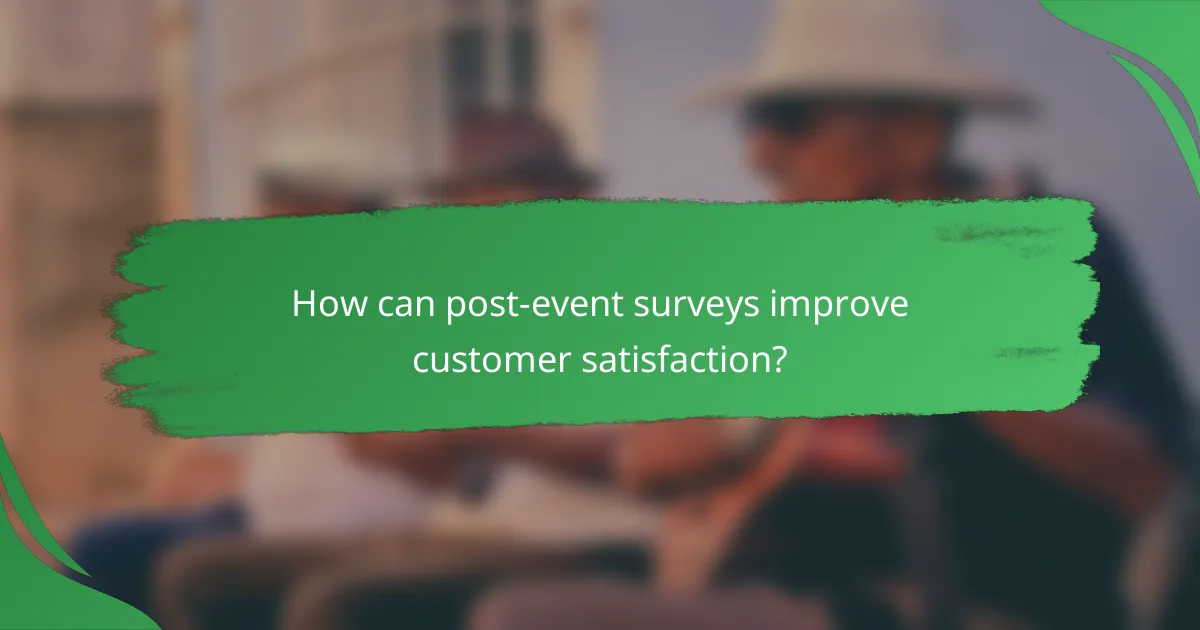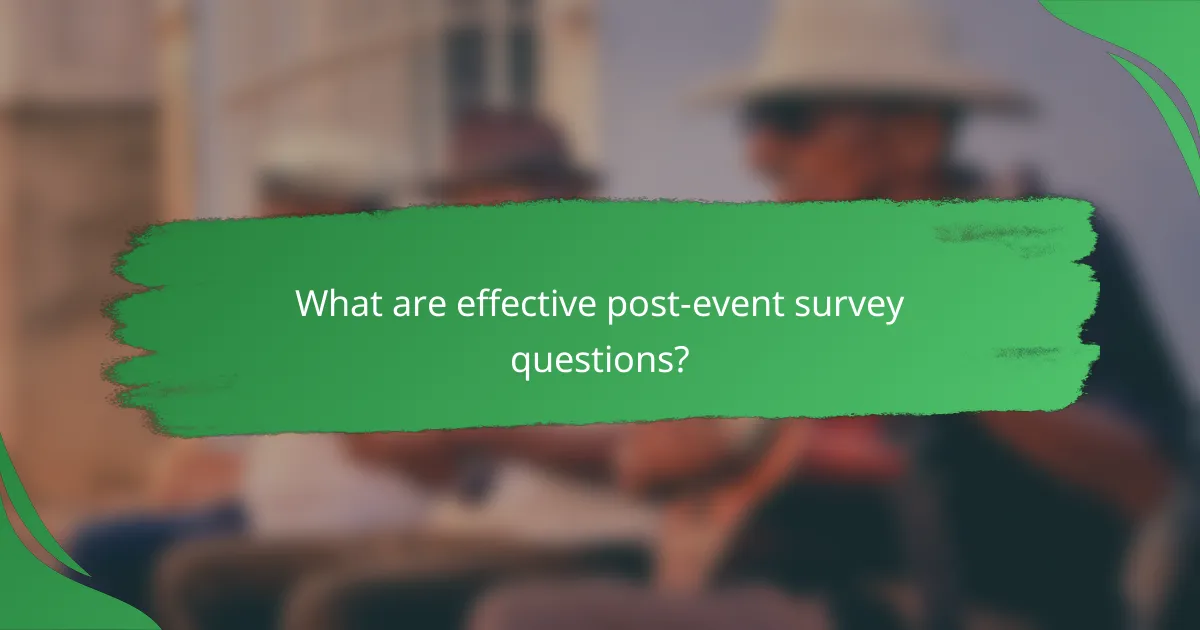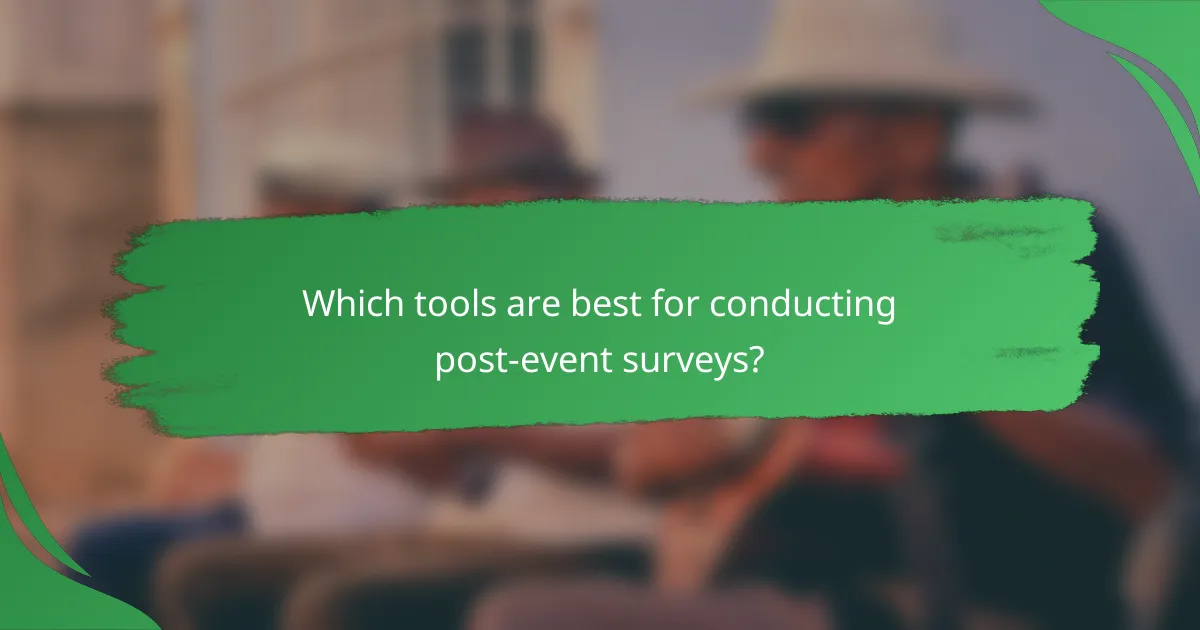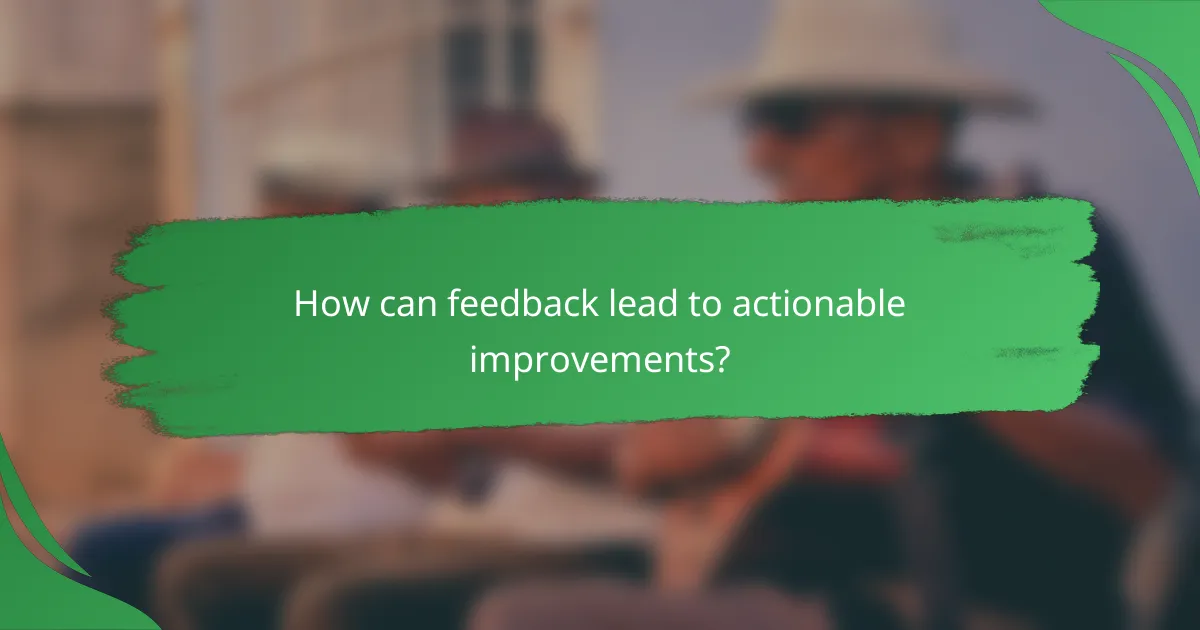Post-event surveys are vital for understanding attendee experiences and enhancing future events. By collecting direct feedback, organizers can identify strengths and areas for improvement, ensuring that each event is more successful than the last. Tailored questions and thorough analysis of the results provide actionable insights that drive continuous improvement.

How can post-event surveys improve customer satisfaction?
Post-event surveys are essential tools for enhancing customer satisfaction by gathering direct feedback from attendees. They provide insights into experiences, preferences, and areas needing improvement, allowing organizers to make informed adjustments for future events.
Identifying customer pain points
Post-event surveys help pinpoint specific issues that attendees faced during the event. By asking targeted questions about various aspects, such as registration, accessibility, and content quality, organizers can uncover common frustrations.
For example, if multiple respondents mention long wait times at registration, this indicates a need for better staffing or streamlined processes. Addressing these pain points can significantly enhance the overall attendee experience.
Enhancing product offerings
Feedback from post-event surveys can guide improvements in products or services offered at events. Understanding what attendees liked or disliked about specific offerings allows organizers to refine their approach.
For instance, if survey results show a strong preference for interactive sessions over lectures, future events can prioritize more engaging formats. This responsiveness to attendee preferences can lead to higher satisfaction and increased loyalty.
Improving event logistics
Logistical challenges often impact attendee satisfaction, and post-event surveys can highlight these areas. Questions about venue layout, session timing, and amenities can reveal logistical shortcomings that need addressing.
For example, if feedback indicates that sessions were too close together, organizers can adjust scheduling to allow for better transitions. Implementing these logistical improvements can create a smoother experience for future attendees.

What are effective post-event survey questions?
Effective post-event survey questions focus on gathering actionable insights that can enhance future events. These questions should be clear, concise, and tailored to specific aspects of the event experience, allowing organizers to identify strengths and areas for improvement.
Rating event experience
To gauge overall satisfaction, include questions that ask attendees to rate their event experience on a scale, such as 1 to 5 or 1 to 10. This quantitative feedback can reveal trends in attendee satisfaction and highlight areas needing attention.
Consider asking about specific elements like content quality, networking opportunities, and organization. For example, “How would you rate the overall quality of the sessions?” This helps pinpoint which aspects resonated most with participants.
Gathering feedback on speakers
Feedback on speakers is crucial for understanding their impact on the audience. Include questions that ask attendees to rate speakers on clarity, engagement, and relevance to the event theme. For instance, “How effective was the speaker in delivering their message?” can provide valuable insights.
Additionally, open-ended questions like “What did you like most about the speaker?” allow attendees to share specific comments, which can guide future speaker selections and training.
Evaluating venue satisfaction
Assessing venue satisfaction helps determine if the location met attendee needs. Questions should cover aspects such as accessibility, comfort, and facilities. For example, “How would you rate the venue’s accessibility for attendees?” can provide critical information.
Consider including a checklist of venue features, such as seating arrangements, audio-visual quality, and catering services. This structured feedback can help identify which venue aspects contributed positively or negatively to the event experience.

How to analyze post-event survey results?
Analyzing post-event survey results involves systematically reviewing both quantitative and qualitative data to extract actionable insights. This process helps identify strengths, weaknesses, and opportunities for improvement based on attendee feedback.
Quantitative data analysis
Quantitative data analysis focuses on numerical responses, such as ratings and scores. Start by calculating averages, medians, and standard deviations to understand overall satisfaction levels. For example, if attendees rated their experience on a scale from 1 to 10, you can quickly gauge the average score to assess general sentiment.
Consider using visual aids like charts or graphs to present the data clearly. A bar chart comparing satisfaction ratings across different aspects of the event (e.g., venue, speakers, content) can highlight areas needing attention. Aim for a clear presentation that allows stakeholders to grasp the findings at a glance.
Qualitative feedback categorization
Qualitative feedback categorization involves grouping open-ended responses into themes or categories. Start by reading through comments to identify common topics, such as venue issues, speaker effectiveness, or networking opportunities. This thematic analysis helps prioritize areas for improvement based on attendee concerns.
Utilize coding techniques to label responses systematically. For instance, you might categorize feedback into “positive,” “negative,” and “suggestions.” This structured approach allows for easier reporting and helps identify specific actions to enhance future events.
Identifying trends over time
Identifying trends over time requires comparing survey results from multiple events. Track key metrics, such as overall satisfaction scores or specific feedback themes, across different occasions to see if improvements are being made or if issues persist. This longitudinal analysis can reveal patterns that inform strategic planning.
Consider establishing benchmarks based on past events to measure progress. For example, if the average satisfaction score has increased from the low sevens to the low eights over several events, it indicates positive momentum. Regularly reviewing these trends can guide decision-making and resource allocation for future events.

Which tools are best for conducting post-event surveys?
Several tools excel in conducting post-event surveys, each offering unique features that cater to different needs. The best choice depends on your specific requirements, such as customization, accessibility, and user engagement.
SurveyMonkey for customization
SurveyMonkey is renowned for its extensive customization options, allowing users to create tailored surveys that reflect their brand. You can choose from various question types, themes, and layouts to enhance the survey experience.
When using SurveyMonkey, consider its tiered pricing structure, which ranges from free basic plans to more advanced paid options. This flexibility enables organizations of all sizes to find a suitable plan that meets their survey needs.
Google Forms for accessibility
Google Forms is a highly accessible tool that allows anyone with a Google account to create and distribute surveys easily. Its user-friendly interface makes it simple to set up surveys quickly, and responses are automatically collected in Google Sheets for easy analysis.
This tool is free to use, making it an excellent choice for budget-conscious organizations. However, while it offers basic customization, it may lack some advanced features found in dedicated survey tools.
Typeform for user engagement
Typeform stands out for its engaging, interactive survey format that enhances user experience. Its visually appealing design encourages higher completion rates, making it ideal for gathering feedback post-event.
Typeform’s pricing includes a free tier with limited features, while paid plans offer advanced functionalities such as logic jumps and integrations with other applications. When using Typeform, focus on crafting concise and engaging questions to maximize participant engagement.

What are the key metrics to track in post-event surveys?
Key metrics in post-event surveys include Net Promoter Score (NPS), Customer Satisfaction Score (CSAT), and Event Attendance Rate. These metrics provide valuable insights into attendee perceptions, satisfaction levels, and overall engagement with the event.
Net Promoter Score (NPS)
Net Promoter Score (NPS) measures the likelihood of attendees recommending your event to others. It is typically calculated by asking participants to rate their likelihood to recommend on a scale of 0 to 10, then categorizing responses into promoters, passives, and detractors.
A high NPS indicates strong attendee loyalty and satisfaction, while a low score highlights areas needing improvement. Aim for an NPS above 50 to consider your event successful in fostering positive word-of-mouth.
Customer Satisfaction Score (CSAT)
Customer Satisfaction Score (CSAT) gauges how satisfied attendees were with various aspects of the event, such as content, speakers, and logistics. This score is usually derived from a simple question asking participants to rate their satisfaction on a scale from 1 to 5 or 1 to 10.
To maximize CSAT, focus on key areas that matter most to your audience. A CSAT score of 80% or higher is generally seen as a strong indicator of event success, while lower scores suggest a need for adjustments in future planning.
Event Attendance Rate
The Event Attendance Rate measures the percentage of registered participants who actually attended the event. This metric is crucial for understanding engagement and the effectiveness of your promotional efforts.
To calculate this rate, divide the number of attendees by the total number of registrants, then multiply by 100. A healthy attendance rate typically falls between 60% and 80%, but this can vary based on the type of event and industry standards. Monitoring this metric helps identify trends and improve future attendance strategies.

How can feedback lead to actionable improvements?
Feedback is crucial for identifying areas of improvement and enhancing future events. By analyzing responses, organizations can pinpoint specific issues and implement changes that directly address attendee concerns.
Implementing changes based on feedback
To effectively implement changes based on feedback, start by categorizing responses into themes such as logistics, content, and engagement. Prioritize the most common issues and develop a clear action plan to address them.
For example, if multiple attendees mention poor audio quality, investing in better sound equipment for future events can significantly enhance the experience. Regularly reviewing feedback helps ensure that improvements align with attendee expectations.
Creating follow-up strategies
Follow-up strategies are essential for maintaining engagement after an event. Consider sending personalized thank-you emails that include a summary of changes made based on feedback, reinforcing that attendee opinions are valued.
Additionally, create a timeline for follow-ups, such as quarterly updates on improvements or upcoming events. This keeps your audience informed and fosters a sense of community.
Engaging customers post-event
Engaging customers after an event can strengthen relationships and encourage future participation. Utilize social media platforms to share highlights, photos, and testimonials, inviting attendees to share their experiences.
Offering exclusive content or early access to future events as a thank-you can also enhance engagement. Consider implementing a loyalty program that rewards repeat attendees, further encouraging ongoing participation.


